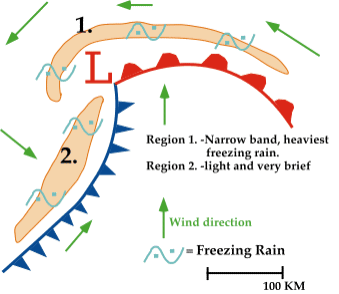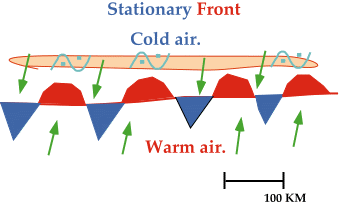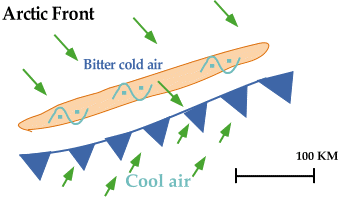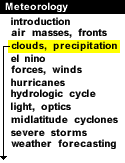
|
In most cases, freezing rain results from the process of warm moist air "overrunning" colder air. Perhaps the most common overrunning scenario occurs as warm moist air flows up and over a warm front associated with a midlatitude cyclone. The rising air cools, the water vapor condenses, producing a narrow band of freezing rain ahead of the front. This band is typically less than 50 kilometers (30 miles) wide and is represented by region #1 (shaded in orange) in the diagram below. This band is often wrapped around and behind the low pressure center by counterclockwise winds flowing around the cyclone. Some of the most devastating ice storms occur in association with this narrow band of freezing rain.

A second area of freezing rain is typically found behind the cold front, (region #2 shaded in orange in the diagram above). Freezing rain develops as southerly winds at upper levels push warm moist air up and over the cold front, producing precipitation that falls into the colder air. Freezing rain associated with the cold front is usually very light and scattered, and in rare cases, even observed ahead of the front.

Stationary fronts can be associated with the production of freezing rain. A stationary front separates cold air to the north from warm moist air to the south. Freezing rain develops as upper-level winds (typically light and southwesterly) push warm moist air over the colder air north of the stationary front, producing a narrow band of freezing rain on the cold side of the frontal boundary.

Arctic air masses are typically very shallow and have been known to produce devastating ice storms. Behind a cold front, the air mass is maritime polar (mP), but behind an Arctic front, the air mass is continental polar (cP). As Arctic air advances, it lifts the warm moist air (ahead of the front), producing precipitation that falls into the Arctic air. Sometimes, a band of freezing rain wider than 50 kilometers develops in association with an Arctic front.

processes |
|

pressure features |






